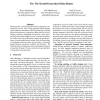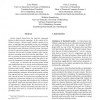15 search results - page 3 / 3 » Simple Circuits that Work for Complicated Reasons |
USS
2004
13 years 7 months ago
2004
We present Tor, a circuit-based low-latency anonymous communication service. This second-generation Onion Routing system addresses limitations in the original design by adding per...
SRDS
2006
IEEE
13 years 11 months ago
2006
IEEE
Failure models characterise the expected component failures in fault-tolerant computing. In the context of distributed systems, a failure model usually consists of two parts: a fu...
SIGCOMM
2010
ACM
13 years 6 months ago
2010
ACM
RSSI is known to be a fickle indicator of whether a wireless link will work, for many reasons. This greatly complicates operation because it requires testing and adaptation to fin...
POPL
2001
ACM
14 years 6 months ago
2001
ACM
We study the interaction of the "new" construct with a rich but common form of (first-order) communication. This interaction is crucial in security protocols, which are ...
LATA
2010
Springer
13 years 9 months ago
2010
Springer
Automated reasoning about systems with infinite domains requires an extension of regular automata to infinite alphabets. Existing formalisms of such automata cope with the infinite...



